formerly eScholarship Editions


|
|
|
|
Your request for similar items found 20 book(s). | Modify Search | Displaying 1 - 20 of 20 book(s) | |
| 1. | 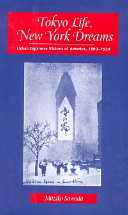 | Title: Tokyo life, New York dreams: urban Japanese visions of America, 1890-1924 Author: Sawada, Mitziko 1928- Published: University of California Press, 1996 Subjects: History | Asian Studies | Japan | Asian American Studies Publisher's Description: Tokyo Life, New York Dreams is a bicultural study focusing on Japanese immigrants in New York and the ideas they had about what they would find there. It is one of the first works to consider Japanese immigration to the East Coast, where immigrants were of a different class and social background from the laborers who came to the West Coast and Hawaii. Beginning with a portrait of immigrants' lives in New York City, Mitziko Sawada returns to Tokyo to examine the pre-immigration experience in depth, using rich sources of popular Japanese literature to trace the origins of immigrant perceptions of the U.S.Along with discussions of economics and politics in Tokyo, Sawada explores the prevalent images, ideologies, social myths, and attitudes of late Meiji and Early Taisho Japan. Her lively narrative draws on guide books, magazines, success literature, and popular novels to illuminate the formation of ideas about work, class, gender relations, and freedom in American society. This study analyzes the Japanese construction of a mythic America, perceived as a homogeneous and exotic "other." [brief] Similar Items |
| 2. | 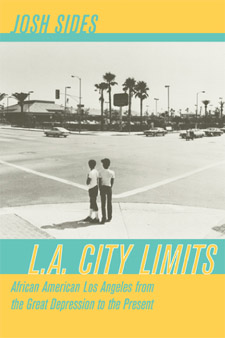 | Title: L.A. city limits: African American Los Angeles from the Great Depression to the present Author: Sides, Josh 1972- Published: University of California Press, 2004 Subjects: History | African American Studies | Urban Studies | Californian and Western History | California and the West Publisher's Description: In 1964 an Urban League survey ranked Los Angeles as the most desirable city for African Americans to live in. In 1965 the city burst into flames during one of the worst race riots in the nation's history. How the city came to such a pass - embodying both the best and worst of what urban America offered black migrants from the South - is the story told for the first time in this history of modern black Los Angeles. A clear-eyed and compelling look at black struggles for equality in L.A.'s neighborhoods, schools, and workplaces from the Great Depression to our day, L.A. City Limits critically refocuses the ongoing debate about the origins of America's racial and urban crisis. Challenging previous analysts' near-exclusive focus on northern "rust-belt" cities devastated by de-industrialization, Josh Sides asserts that the cities to which black southerners migrated profoundly affected how they fared. He shows how L.A.'s diverse racial composition, dispersive geography, and dynamic postwar economy often created opportunities - and limits - quite different from those encountered by blacks in the urban North. [brief] Similar Items |
| 3. | 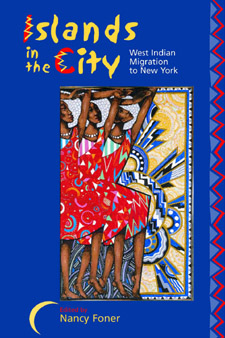 | Title: Islands in the city: West Indian migration to New York Author: Foner, Nancy 1945- Published: University of California Press, 2001 Subjects: Anthropology | Ethnic Studies | Cultural Anthropology | Social Problems Publisher's Description: This collection of original essays draws on a variety of theoretical perspectives, methodologies, and empirical data to explore the effects of West Indian migration and to develop analytic frameworks to examine it. Similar Items |
| 4. | 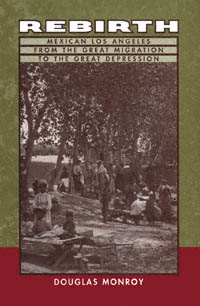 | Title: Rebirth: Mexican Los Angeles from the great migration to the Great Depression Author: Monroy, Douglas Published: University of California Press, 1999 Subjects: History | Latino Studies | United States History | California and the West Publisher's Description: This sweeping, vibrant narrative chronicles the history of the Mexican community in Los Angeles. Douglas Monroy unravels the dramatic, complex story of Mexican immigration to Los Angeles during the early decades of the twentieth century and shows how Mexican immigrants re-created their lives and their communities. Against the backdrop of this newly created cityscape, Rebirth explores pivotal aspects of Mexican Los Angeles during this time - its history, political economy, popular culture - and depicts the creation of a time and place unique in Californian and American history.Mexican boxers, movie stars, politicians, workers, parents, and children, American popular culture and schools, and historical fervor on both sides of the border all come alive in this literary, jargon-free chronicle. In addition to the colorful unfolding of the social and cultural life of Mexican Los Angeles, Monroy tells a story of first-generation immigrants that provides important points of comparison for understanding other immigrant groups in the United States.Monroy shows how the transmigration of space, culture, and reality from Mexico to Los Angeles became neither wholly American nor Mexican, but México de afuera , "Mexico outside," a place where new concerns and new lives emerged from what was both old and familiar. This extremely accessible work uncovers the human stories of a dynamic immigrant population and shows the emergence of a truly transnational history and culture. Rebirth provides an integral piece of Chicano history, as well as an important element of California urban history, with the rich, synthetic portrait it gives of Mexican Los Angeles. [brief] Similar Items |
| 5. | 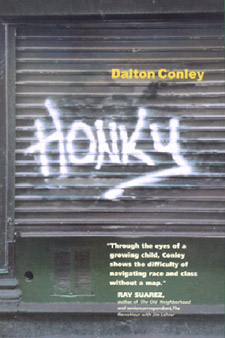 | Title: Honky Author: Conley, Dalton 1969- Published: University of California Press, 2000 Subjects: Sociology | Urban Studies | American Studies | Autobiography Publisher's Description: This intensely personal and engaging memoir is the coming-of-age story of a white boy growing up in a neighborhood of predominantly African American and Latino housing projects on New York's Lower East Side. Vividly evoking the details of city life from a child's point of view - the streets, buses, and playgrounds - Honky poignantly illuminates the usual vulnerabilities of childhood complicated by unusual circumstances. As he narrates these sharply etched and often funny memories, Conley shows how race and class shaped his life and the lives of his schoolmates and neighbors. A brilliant case study for illuminating the larger issues of inequality in American society, Honky brings us to a deeper understanding of the privilege of whiteness, the social construction of race, the power of education, and the challenges of inner-city life. Conley's father, a struggling artist, and his mother, an aspiring writer, joined Manhattan's bohemian subculture in the late 1960s, living on food stamps and raising their family in a housing project. We come to know his mother: her quirky tastes, her robust style, and the bargains she strikes with Dalton - not to ride on the backs of buses, and to always carry money in his shoe as protection against muggers. We also get to know his father, his face buried in racing forms, and his sister, who in grade school has a burning desire for cornrows. From the hilarious story of three-year-old Dalton kidnapping a black infant so he could have a baby sister to the deeply disturbing shooting of a close childhood friend, this memoir touches us with movingly rendered portraits of people and the unfolding of their lives. Conley's story provides a sophisticated example of the crucial role culture plays in defining race and class. Both of Conley's parents retained the "cultural capital" of the white middle class, and they passed this on to their son in the form of tastes, educational expectations, and a general sense of privilege. It is these advantages that ultimately provide Conley with his ticket to higher education and beyond. A tremendously good read, Honky addresses issues both timely and timeless that pertain to us all. [brief] Similar Items |
| 6. | 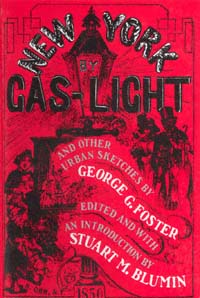 | Title: New York by gas-light and other urban sketches Author: Foster, George G d. 1856 Published: University of California Press, 1990 Subjects: History | United States History | Print Media | Urban Studies | Technology and Society Publisher's Description: First published in 1850, New York by Gas-Light explores the seamy side of the newly emerging metropolis: "the festivities of prostitution, the orgies of pauperism, the haunts of theft and murder, the scenes of drunkenness and beastly debauch, and all the sad realities that go to make up the lower stratum - the underground story - of life in New York!" The author of this lively and fascinating little book, which both attracted and offended large numbers of readers in Victorian America, was George G. Foster, reporter for Horace Greeley's influential New York Tribune, social commentator, poet, and man about town. Foster drew on his daily and nightly rambles through the city's streets and among the characters of the urban demi-monde to produce a sensationalized but extraordinarily revealing portrait of New York at the moment it was emerging as a major metropolis. Reprinted here with sketches from two of Foster's other books, New York by Gas-Light will be welcomed by students of urban social history, popular culture, literature, and journalism.Editor Stuart M. Blumin has provided a penetrating introductory essay that sets Foster's life and work in the contexts of the growing city, the development of the mass-distribution publishing industry, the evolving literary genre of urban sensationalism, and the wider culture of Victorian America. This is an important reintroduction to a significant but neglected work, a prologue to the urban realism that would flourish later in the fiction of Stephen Crane, the painting of George Bellows, and the journalism of Jacob Riis. [brief] Similar Items |
| 7. | 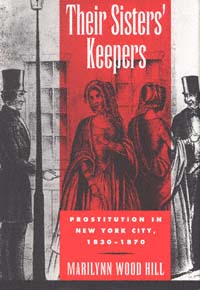 | Title: Their sisters' keepers: prostitution in New York City, 1830-1870 Author: Hill, Marilynn Wood Published: University of California Press, 1993 Subjects: History | United States History | Women's Studies | American Studies Publisher's Description: This intimate study of prostitutes in New York City during the mid-nineteenth century reveals these women in an entirely new light. Unlike traditional studies, Marilynn Wood Hill's account of prostitution's positive attractions, as well as its negative aspects, gives a fresh perspective to this much-discussed occupation.Using a wealth of primary source material, from tax and court records to brothel guidebooks and personal correspondence, Hill shows the common concerns prostitutes shared with women outside the "profession." As mothers, sisters, daughters, and wives, trapped by circumstances, they sought a way to create a life and work culture for themselves and those they cared about.By the 1830s prostitution in New York was no longer hidden. Though officially outside the law, it was well integrated into the city's urban life. Hill documents the discrimination and legal harassment prostitutes suffered, and shows how they asserted their rights to protect themselves and their property. Although their occupation was frequently degrading and dangerous, it offered economic and social opportunities for many of its practitioners. Women controlled the prostitution business until about 1870, and during this period female employers and their employees often achieved economic goals not generally available to other working women.While examining aspects of prostitution that benefited women, Hill's vivid portrayal also makes evident the hardships that prostitutes endured. What emerges is a fully rounded study that will be welcomed by many readers. [brief] Similar Items |
| 8. | 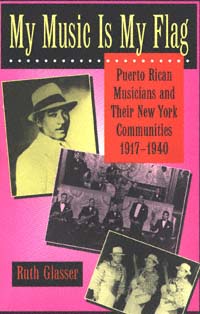 | Title: My music is my flag: Puerto Rican musicians and their New York communities, 1917-1940 Author: Glasser, Ruth Published: University of California Press, 1995 Subjects: History | American Studies | Music Publisher's Description: Puerto Rican music in New York is given center stage in Ruth Glasser's original and lucid study. Exploring the relationship between the social history and forms of cultural expression of Puerto Ricans, she focuses on the years between the two world wars. Her material integrates the experiences of the mostly working-class Puerto Rican musicians who struggled to make a living during this period with those of their compatriots and the other ethnic groups with whom they shared the cultural landscape.Through recorded songs and live performances, Puerto Rican musicians were important representatives for the national consciousness of their compatriots on both sides of the ocean. Yet they also played with African-American and white jazz bands, Filipino or Italian-American orchestras, and with other Latinos. Glasser provides an understanding of the way musical subcultures could exist side by side or even as a part of the mainstream, and she demonstrates the complexities of cultural nationalism and cultural authenticity within the very practical realm of commercial music.Illuminating a neglected epoch of Puerto Rican life in America, Glasser shows how ethnic groups settling in the United States had choices that extended beyond either maintenance of their homeland traditions or assimilation into the dominant culture. Her knowledge of musical styles and performance enriches her analysis, and a discography offers a helpful addition to the text. [brief] Similar Items |
| 9. | 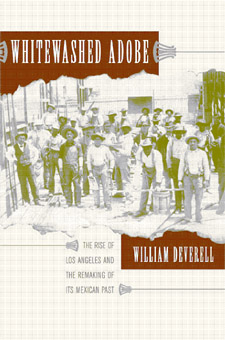 | Title: Whitewashed adobe: the rise of Los Angeles and the remaking of its Mexican past Author: Deverell, William Francis Published: University of California Press, 2004 Subjects: History | Californian and Western History | Chicano Studies | American Studies | Urban Studies Publisher's Description: Chronicling the rise of Los Angeles through shifting ideas of race and ethnicity, William Deverell offers a unique perspective on how the city grew and changed. Whitewashed Adobe considers six different developments in the history of the city - including the cementing of the Los Angeles River, the outbreak of bubonic plague in 1924, and the evolution of America's largest brickyard in the 1920s. In an absorbing narrative supported by a number of previously unpublished period photographs, Deverell shows how a city that was once part of Mexico itself came of age through appropriating - and even obliterating - the region's connections to Mexican places and people. Deverell portrays Los Angeles during the 1850s as a city seething with racial enmity due to the recent war with Mexico. He explains how, within a generation, the city's business interests, looking for a commercially viable way to establish urban identity, borrowed Mexican cultural traditions and put on a carnival called La Fiesta de Los Angeles. He analyzes the subtle ways in which ethnicity came to bear on efforts to corral the unpredictable Los Angeles River and shows how the resident Mexican population was put to work fashioning the modern metropolis. He discusses how Los Angeles responded to the nation's last major outbreak of bubonic plague and concludes by considering the Mission Play, a famed drama tied to regional assumptions about history, progress, and ethnicity. Taking all of these elements into consideration, Whitewashed Adobe uncovers an urban identity - and the power structure that fostered it - with far-reaching implications for contemporary Los Angeles. [brief] Similar Items |
| 10. | 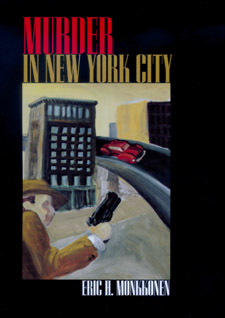 | Title: Murder in New York City Author: Monkkonen, Eric H 1942- Published: University of California Press, 2001 Subjects: American Studies | Psychology | Criminology | United States History Publisher's Description: Murder in New York City dramatically expands what we know about urban homicide, and challenges some of the things we think we know. Eric Monkkonen's unprecedented investigation covers two centuries of murder in America's biggest city, combining newly assembled statistical evidence with many other documentary sources to tease out the story behind the figures. As we generally believe, the last part of the twentieth century was unusually violent, but there have been other high-violence eras as well: the late 1920s and the mid-nineteenth century, the latter because the absence of high-quality weapons and ammunition makes that era's stabbings and beatings seem almost more vicious. Monkkonen's long view allows us to look back to a time when guns were rarer, when poverty was more widespread, and when racial discrimination was more intense, and to ask what difference these things made. With many vivid case studies for illustration, he examines the crucial factors in killing through the years: the weapons of choice, the sex and age of offenders and victims, the circumstances and settings in which homicide tends to occur, and the race and ethnicity of murderers and their victims. In a final chapter, Monkkonen looks to the international context and shows that New York - and, by extension, the United States - has had consistently higher violence levels than London and Liverpool. No single factor, he says, shapes this excessive violence, but exploring the variables of age, ethnicity, weapons, and demography over the long term can lead to hope of changing old patterns. [brief] Similar Items |
| 11. | 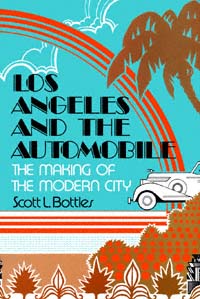 | Title: Los Angeles and the automobile: the making of the modern city Author: Bottles, Scott L Published: University of California Press, 1987 Subjects: American Studies | Californian and Western History | Urban Studies | United States History | American Studies Publisher's Description: More comprehensive than any other book on this topic, Los Angeles and the Automobile places the evolution of Los Angeles within the context of American political and urban history. Similar Items |
| 12. | 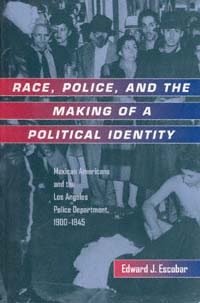 | Title: Race, police, and the making of a political identity: Mexican Americans and the Los Angeles Police Department, 1900-1945 Author: Escobar, Edward J 1946- Published: University of California Press, 1999 Subjects: History | California and the West | Latin American History | Latino Studies | Social Problems | Politics | Californian and Western History | Urban Studies | Criminology | Criminology Publisher's Description: In June 1943, the city of Los Angeles was wrenched apart by the worst rioting it had seen to that point in the twentieth century. Incited by sensational newspaper stories and the growing public hysteria over allegations of widespread Mexican American juvenile crime, scores of American servicemen, joined by civilians and even police officers, roamed the streets of the city in search of young Mexican American men and boys wearing a distinctive style of dress called a Zoot Suit. Once found, the Zoot Suiters were stripped of their clothes, beaten, and left in the street. Over 600 Mexican American youths were arrested. The riots threw a harsh light upon the deteriorating relationship between the Los Angeles Mexican American community and the Los Angeles Police Department in the 1940s.In this study, Edward J. Escobar examines the history of the relationship between the Los Angeles Police Department and the Mexican American community from the turn of the century to the era of the Zoot Suit Riots. Escobar shows the changes in the way police viewed Mexican Americans, increasingly characterizing them as a criminal element, and the corresponding assumption on the part of Mexican Americans that the police were a threat to their community. The broader implications of this relationship are, as Escobar demonstrates, the significance of the role of the police in suppressing labor unrest, the growing connection between ideas about race and criminality, changing public perceptions about Mexican Americans, and the rise of Mexican American political activism. [brief] Similar Items |
| 13. | 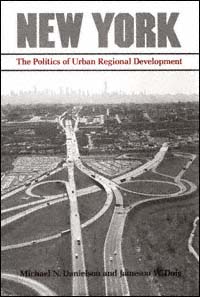 | Title: New York, the politics of urban regional development Author: Danielson, Michael N Published: University of California Press, 1982 Subjects: Urban Studies Similar Items |
| 14. | 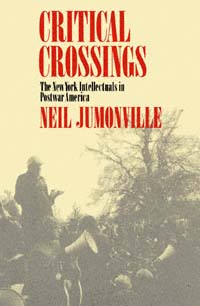 | Title: Critical crossings: the New York intellectuals in postwar America Author: Jumonville, Neil Published: University of California Press, 1990 Subjects: History | Autobiographies and Biographies | Sociology | Politics | American Studies Publisher's Description: The period immediately following the Second World War was a time, observed Randall Jarrell, when many American writers looked to the art of criticism as the representative act of the intellectual. Rethinking this interval in our culture, Neil Jumonville focuses on the group of writers and thinkers who founded, edited, and wrote for some of the most influential magazines in the country, including Partisan Review , Politics , Commentary , and Dissent . In their rejection of ideological, visionary, and romantic outlooks, reviewers and essayists such as Sidney Hook, Irving Howe, Lionel Trilling, Harold Rosenberg, and Daniel Bell adopted a pragmatic criticism that had a profound influence on the American intellectual community. By placing pragmatism at the center of intellectual activity, the New York Critics crossed from large belief systems to more tentative answers in the hope of redefining the proper function of the intellectual in the new postwar world.Because members of the New York group always valued being intellectuals more than being political leftists, they adopted a cultural elitism that opposed mass culture. Ready to combat any form of absolutist thought, they found themselves pitted against a series of antagonists, from the 1930s to the present, whom they considered insufficiently rational and analytical to be good intellectuals: the Communists and their sympathizers, the Beat writers, and the New Left. Jumonville tells the story of some of the paradoxes and dilemmas that confront all intellectuals. In this sense the book is as much about what it means to be an intellectual as it is about a specific group of thinkers. [brief] Similar Items |
| 15. | 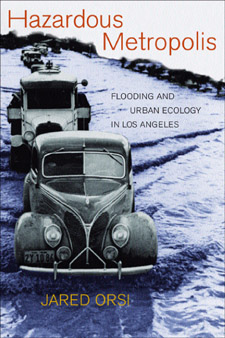 | Title: Hazardous metropolis: flooding and urban ecology in Los Angeles Author: Orsi, Jared 1970- Published: University of California Press, 2004 Subjects: History | California and the West | Urban Studies | Water | Urban Studies Publisher's Description: Although better known for its sunny skies, Los Angeles suffers devastating flooding. This book explores a fascinating and little-known chapter in the city's history - the spectacular failures to control floods that occurred throughout the twentieth century. Despite the city's 114 debris dams, 5 flood control basins, and nearly 500 miles of paved river channels, Southern Californians have discovered that technologically engineered solutions to flooding are just as disaster-prone as natural waterways. Jared Orsi's lively history unravels the strange and often hazardous ways that engineering, politics, and nature have come together in Los Angeles to determine the flow of water. He advances a new paradigm - the urban ecosystem - for understanding the city's complex and unpredictable waterways and other issues that are sure to play a large role in future planning. As he traces the flow of water from sky to sea, Orsi brings together many disparate and intriguing pieces of the story, including local and national politics, the little-known San Gabriel Dam fiasco, the phenomenal growth of Los Angeles, and, finally, the influence of environmentalism. Orsi provocatively widens his vision toward other cities for which Los Angeles may offer a lesson - both of things gone wrong and a glimpse of how they might be improved. [brief] Similar Items |
| 16. | 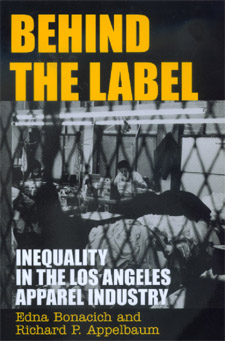 | Title: Behind the label: inequality in the Los Angeles apparel industry Author: Bonacich, Edna Published: University of California Press, 2000 Subjects: Sociology | Social Problems | California and the West | Labor Studies | Economics and Business | Urban Studies | American Studies | Ethnic Studies Publisher's Description: In a study crucial to our understanding of American social inequality, Edna Bonacich and Richard Appelbaum investigate the return of sweatshops to the apparel industry, especially in Los Angeles. The "new" sweatshops, they say, need to be understood in terms of the decline in the American welfare state and its strong unions and the rise in global and flexible production. Apparel manufacturers now have the incentive to move production to wherever low-wage labor can be found, while maintaining arm's-length contractual relations that protect them from responsibility. The flight of the industry has led to a huge rise in apparel imports to the United States and to a decline in employment. Los Angeles, however, remains a puzzling exception in that its industry employment has continued to grow, to the point where L.A. is the largest center of apparel production in the nation. Not only the availability of low-wage immigrant (often undocumented) workers but also the focus on moderately priced, fashion-sensitive women's wear makes this possible. Behind the Label examines the players in the L.A. apparel industry, including manufacturers, retailers, contractors, and workers, evaluating the maldistribution of wealth and power. The authors explore government and union efforts to eradicate sweatshops while limiting the flight to Mexico and elsewhere, and they conclude with a description of the growing antisweatshop movement. Los Angeles Times Best Nonfiction Book of 2000 [brief] Similar Items |
| 17. | 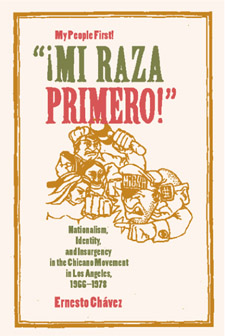 | Title: "Mi raza primero!" (My people first!): nationalism, identity, and insurgency in the Chicano movement in Los Angeles, 1966-1978 Author: Chávez, Ernesto 1962- Published: University of California Press, 2002 Subjects: History | California and the West | Californian and Western History | Chicano Studies | Sociology | Politics | Social Problems | Immigration Publisher's Description: ¡Mi Raza Primero! is the first book to examine the Chicano movement's development in one locale - in this case Los Angeles, home of the largest population of people of Mexican descent outside of Mexico City. Ernesto Chávez focuses on four organizations that constituted the heart of the movement: The Brown Berets, the Chicano Moratorium Committee, La Raza Unida Party, and the Centro de Acción Social Autónomo, commonly known as CASA. Chávez examines and chronicles the ideas and tactics of the insurgency's leaders and their followers who, while differing in their goals and tactics, nonetheless came together as Chicanos and reformers. Deftly combining personal recollection and interviews of movement participants with an array of archival, newspaper, and secondary sources, Chávez provides an absorbing account of the events that constituted the Los Angeles-based Chicano movement. At the same time he offers insights into the emergence and the fate of the movement elsewhere. He presents a critical analysis of the concept of Chicano nationalism, an idea shared by all leaders of the insurgency, and places it within a larger global and comparative framework. Examining such variables as gender, class, age, and power relationships, this book offers a sophisticated consideration of how ethnic nationalism and identity functioned in the United States during the 1960s and 1970s. [brief] Similar Items |
| 18. | 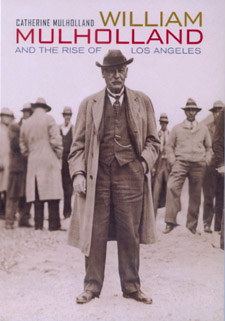 | Title: William Mulholland and the rise of Los Angeles Author: Mulholland, Catherine 1923- Published: University of California Press, 2000 Subjects: History | California and the West | Californian and Western History | Autobiographies and Biographies Publisher's Description: William Mulholland presided over the creation of a water system that forever changed the course of southern California's history. Mulholland, a self-taught engineer, was the chief architect of the Owens Valley Aqueduct - a project ranking in magnitude and daring with the Panama Canal - that brought water to semi-arid Los Angeles from the lush Owens Valley. The story of Los Angeles's quest for water is both famous and notorious: it has been the subject of the classic yet historically distorted movie Chinatown, as well as many other accounts. This first full-length biography of Mulholland challenges many of the prevailing versions of his life story and sheds new light on the history of Los Angeles and its relationship with its most prized resource: water. Catherine Mulholland, the engineer's granddaughter, provides insights into this story that family familiarity affords, and adds to our historical understanding with extensive primary research in sources such as Mulholland's recently uncovered office files, newspapers, and Department of Water and Power archives. She scrutinizes Mulholland's life - from his childhood in Ireland to his triumphant completion of the Owens Valley Aqueduct to the tragedy that ended his career. This vivid portrait of a rich chapter in the history of Los Angeles is enhanced with a generous selection of previously unpublished photographs. Los Angeles Times Best Nonfiction Book of 2000 [brief] Similar Items |
| 19. | 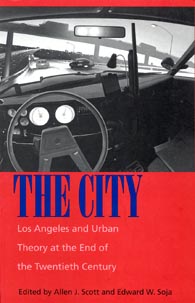 | Title: The city: Los Angeles and urban theory at the end of the twentieth century Author: Scott, Allen John Published: University of California Press, 1997 Subjects: Urban Studies | Geography | Sociology | California and the West | American Studies Publisher's Description: Los Angeles has grown from a scattered collection of towns and villages to one of the largest megacities in the world. In the process, it has inspired controversy among critics and scholars, as well as among its residents. Seeking original perspectives rather than consensus, the editors of The City have assembled a variety of essays examining the built environment and human dynamics of this extraordinary modern city, emphasizing the dramatic changes that have occurred since 1960. Together the essays - by experts in urban planning, architecture, geography, and sociology - create a new kind of urban analysis, one that is open to diversity but strongly committed to collective theoretical and practical understanding. [brief] Similar Items |
| 20. | 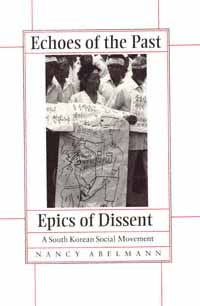 | Title: Echoes of the past, epics of dissent: a South Korean social movement Author: Abelmann, Nancy Published: University of California Press, 1996 Subjects: Anthropology | Asian Studies | Politics | Sociology | Cultural Anthropology Publisher's Description: Echoes of the Past, Epics of Dissent , the story of a South Korean social movement, offers a window to a decade of tumultuous social protest in a postcolonial, divided nation. Abelmann brings a dramatic chapter of modern Korean history to life - a period in which farmers, student activists, and organizers joined to protest the corporate ownership of tenant plots never distributed in the 1949 Land Reform.From public sites of protest to backstage meetings and negotiations, from farming villages to university campuses, Abelmann's highly original study explores this movement as a complex process always in the making. Her discussion moves fluently between past and present, local and national, elites and dominated, and urban and rural. Touching on major historical issues, this ethnography of dissent explores contemporary popular nationalism and historical consciousness. [brief] Similar Items |